BPH Decongestant Risk Calculator
Enter your details to see your personalized risk of urinary retention when taking decongestants.
Personalized Risk Assessment
Enter your information to see your risk assessment.
Risk Level
Recommended Actions
Key factors influencing your risk:
Men over 50 with an enlarged prostate - a condition called benign prostatic hyperplasia (BPH) - often face a silent danger when they reach for a common cold medicine. Many don’t realize that a simple decongestant like pseudoephedrine, found in Sudafed and dozens of over-the-counter cold remedies, can trigger a medical emergency: acute urinary retention. This isn’t a rare side effect. It’s a well-documented, preventable risk that affects thousands every year.
What Is Benign Prostatic Hyperplasia?
BPH means your prostate gland has grown larger, pressing on the urethra and making it harder to urinate. It’s not cancer, and it’s not unusual. By age 60, about half of all men have it. By 85, that number jumps to 90%. Symptoms include a weak urine stream, needing to pee frequently, especially at night, and feeling like your bladder isn’t empty even after you’ve gone. These symptoms get worse over time, but they’re manageable - unless you take the wrong medication.
Why Decongestants Are Dangerous for Men with BPH
Decongestants like pseudoephedrine and phenylephrine work by narrowing blood vessels in your nose to reduce swelling. But they don’t stop there. These drugs also activate alpha-1 receptors in your prostate and bladder neck - areas packed with smooth muscle. When stimulated, that muscle tightens, squeezing the urethra even more. For a man with BPH, this is like adding a second knot to a rope that’s already half-tied.
Studies show pseudoephedrine can increase urethral resistance by 35-40%. In men with moderate to severe BPH, this can completely block urine flow. A 2021 study in the Journal of Urology found that men with BPH who took pseudoephedrine were nearly three times more likely to experience acute urinary retention - a condition where you can’t pee at all, your bladder swells painfully, and you need a catheter to drain it.
The Real Numbers Behind the Risk
Here’s what the data says:
- Pseudoephedrine increases the risk of acute urinary retention by 2.8-fold in men with BPH.
- Men over 70 have a 51.8% chance of developing subclinical voiding dysfunction after taking pseudoephedrine - meaning their urinary symptoms worsen even if they don’t fully stop peeing.
- 85% of acute urinary retention cases in men over 65 with BPH are linked to decongestant use, according to the NIH.
- 70% of men who develop retention after taking decongestants need a catheter for 48-72 hours.
Even a single 30mg dose - the standard tablet - can cause trouble. One Reddit user, u/BPH_Warrior, described how after taking Sudafed for a cold, he couldn’t urinate for 12 hours. "I could feel my bladder filling but couldn’t push anything out," he wrote. "It was terrifying."
Not All Decongestants Are the Same
Some decongestants are riskier than others:
| Decongestant | Typical Dose | Relative Risk (Odds Ratio) | Notes |
|---|---|---|---|
| Pseudoephedrine | 30-120 mg | 3.45 | Highest risk. Long half-life (12-16 hours). Found in Sudafed, Claritin-D. |
| Phenylephrine | 10-20 mg | 2.15 | Lower risk than pseudoephedrine, but still dangerous. Common in store-brand cold meds. |
| Oxymetazoline (nasal spray) | 0.05% spray | 1.25 | Minimal systemic absorption. Safer option if used as directed. |
| Diphenhydramine (Benadryl) | 25-50 mg | 2.85 | Antihistamine with strong anticholinergic effects - also risky for BPH. |
| Loratadine (Claritin) | 10 mg | 1.35 | Non-sedating antihistamine. Minimal urinary risk. Safer alternative. |
Even nasal sprays like oxymetazoline (Afrin) are safer because they don’t enter your bloodstream much. But don’t use them for more than three days - they cause rebound congestion.
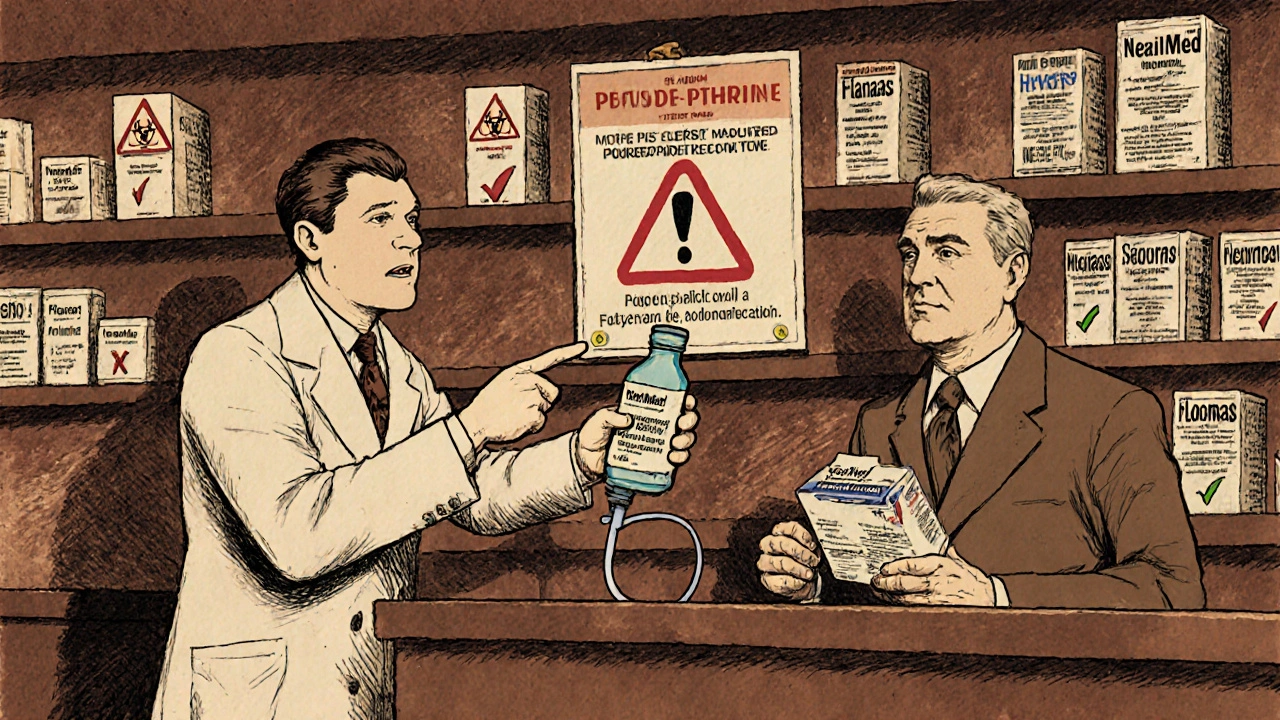
What Should You Do Instead?
If you have BPH and need relief from congestion, here’s what works - without risking urinary retention:
- Saline nasal irrigation - Using a neti pot or NeilMed Sinus Rinse clears mucus without drugs. A 2022 Cochrane Review found it effective in 68% of users.
- Intranasal corticosteroids - Fluticasone (Flonase) or mometasone (Nasonex) reduce nasal inflammation with zero urinary side effects. Effective in 72% of cases.
- Loratadine or cetirizine - These antihistamines don’t block bladder function like older ones (e.g., Benadryl). They’re safe for BPH patients.
- Steam inhalation - Breathing in warm, moist air loosens mucus. Simple, free, and risk-free.
One user on Amazon, reviewing NeilMed Sinus Rinse, wrote: "I’ve been using this for 3 years since my BPH diagnosis. No more Sudafed. No more trips to the ER. Best decision I ever made."
When Is It Okay to Use a Decongestant?
Some experts say occasional, low-dose pseudoephedrine might be acceptable for men with very mild BPH (IPSS score under 8) - but only under a doctor’s supervision. The Cleveland Clinic found that if you take an alpha-blocker like tamsulosin (Flomax) for at least 72 hours before using pseudoephedrine, your risk of retention drops by 85%.
But here’s the catch: most men don’t know they have BPH until it’s too late. And even if you think your symptoms are "mild," your prostate might be more sensitive than you realize. The American Urological Association recommends avoiding all systemic alpha-agonists in men with BPH - period.
What Your Pharmacist Should Be Asking You
In 2022, the FDA required all pseudoephedrine packaging to include a warning about urinary retention in men with BPH. But that doesn’t mean everyone reads it. A 2023 report showed that 73% of pseudoephedrine sales happen without any pharmacist counseling.
That’s why the American Pharmacists Association now recommends that pharmacists screen every man over 50 who buys decongestants. Ask: "Do you have trouble urinating? Do you take medication for your prostate?" If the answer is yes - don’t sell it. Offer alternatives.
Many men don’t connect their urinary symptoms to their cold medicine. They blame the cold. They blame aging. They don’t realize the drug they took for a stuffy nose might have caused them to be hospitalized.
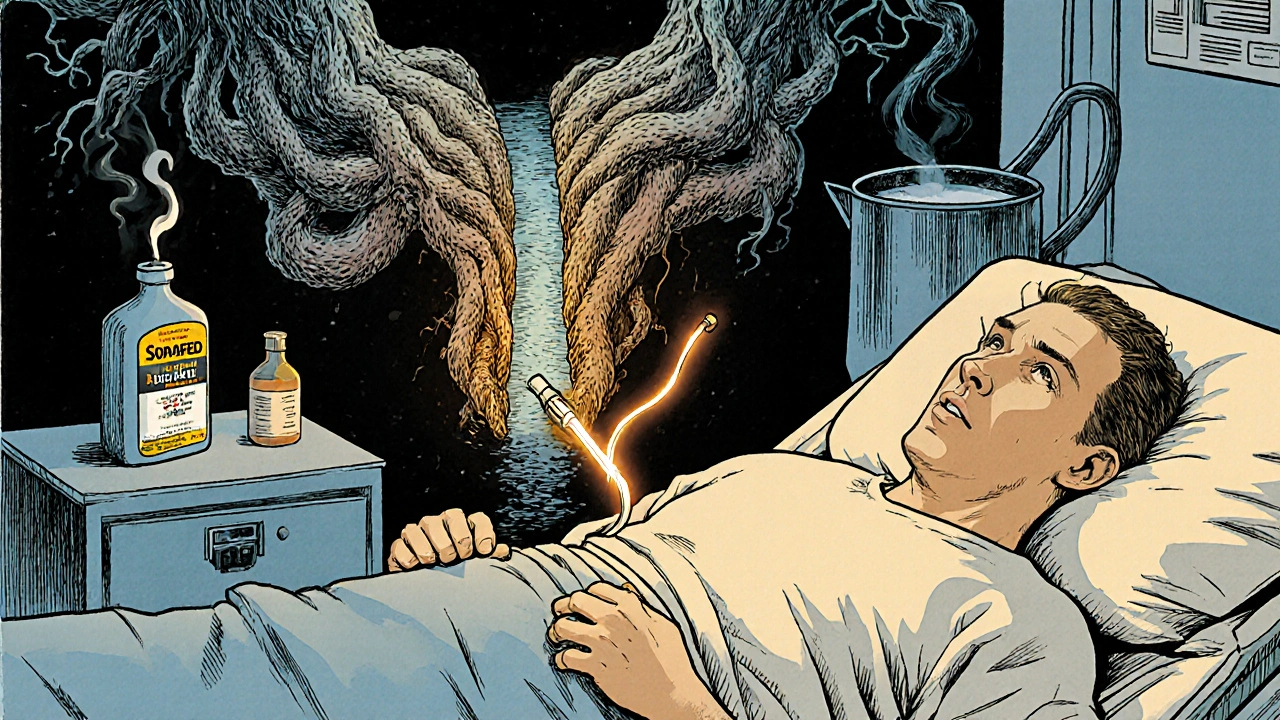
What to Watch For - Early Signs of Urinary Retention
If you’ve taken a decongestant and notice any of these, don’t wait:
- Your urine stream is weaker than usual
- You’re straining harder to start peeing
- You feel like you need to go but can’t produce much
- Your lower abdomen feels full or bloated
These are warning signs. If you can’t pee within 6-8 hours after taking a decongestant, go to the ER. Waiting can damage your bladder.
What’s Changing in 2025?
The medical community is waking up. The European Association of Urology now recommends complete avoidance of all systemic alpha-agonists in men with BPH. The American Geriatrics Society’s 2023 Beers Criteria lists pseudoephedrine as "potentially inappropriate" for men over 65 with BPH.
There’s even new hope on the horizon. Purdue Pharma’s experimental drug PF-06943303 - a bladder-selective alpha-blocker - showed 92% effectiveness in preventing pseudoephedrine-induced retention in Phase II trials. FDA Priority Review was granted in August 2023. This could mean a future where men with BPH can safely take decongestants - but we’re not there yet.
Bottom Line: Play It Safe
If you have an enlarged prostate, avoid pseudoephedrine and phenylephrine. Period. Don’t assume your symptoms are "mild enough." Don’t trust that "I’ve used it for years without issue" - that’s luck, not safety.
Use saline rinses. Use nasal sprays like Flonase. Use loratadine for allergies. Talk to your doctor or pharmacist before taking any cold or sinus medication. And if you ever feel like you can’t pee after taking a decongestant - go to the hospital. Your bladder doesn’t wait.
This isn’t about fear. It’s about awareness. Thousands of men face this risk every year - and most of them never knew it was the medicine, not their prostate, that caused the problem. Now you do.
Can I take Sudafed if I have an enlarged prostate?
No. Sudafed contains pseudoephedrine, a decongestant that can cause acute urinary retention in men with benign prostatic hyperplasia (BPH). Studies show it increases the risk of not being able to urinate by nearly three times. Even a single dose can trigger a medical emergency. Avoid it completely.
What decongestants are safe for men with BPH?
Nasal sprays like oxymetazoline (Afrin) are safer because they’re absorbed minimally into the bloodstream. But use them for no more than three days. The safest options are non-medication approaches: saline nasal rinses and steam inhalation. If you need medication, intranasal corticosteroids like Flonase or non-sedating antihistamines like loratadine (Claritin) are preferred.
How long does it take for pseudoephedrine to affect urination?
Effects can begin within 30-60 minutes after taking pseudoephedrine. Symptoms like a weaker urine stream or increased straining may appear quickly. Complete urinary retention can develop within 4-12 hours. Because pseudoephedrine has a half-life of 12-16 hours, the risk lasts up to 24 hours after a single dose.
Can BPH be reversed by stopping decongestants?
No. Stopping decongestants won’t shrink your prostate or reverse BPH. But it can prevent sudden worsening of symptoms and avoid acute urinary retention - a dangerous complication. Once the drug clears your system, urinary flow usually returns to baseline, but the underlying prostate enlargement remains.
Should I tell my urologist if I’ve taken Sudafed?
Yes. Always disclose all medications - including over-the-counter ones - to your urologist. Even if you didn’t have symptoms, your doctor needs to know about potential drug-induced complications. This helps them assess your risk level and adjust your treatment plan if needed.

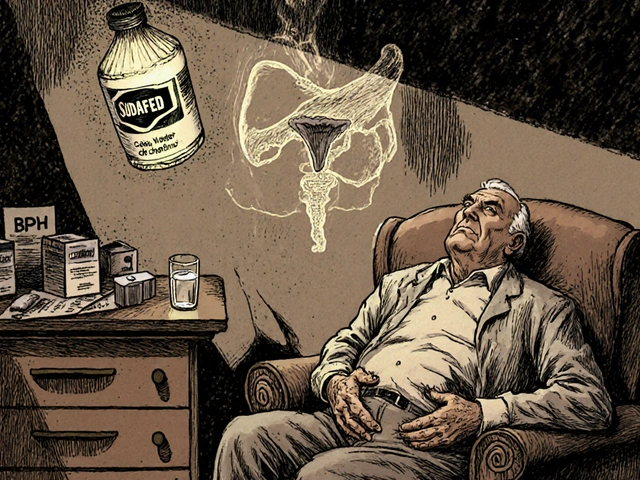
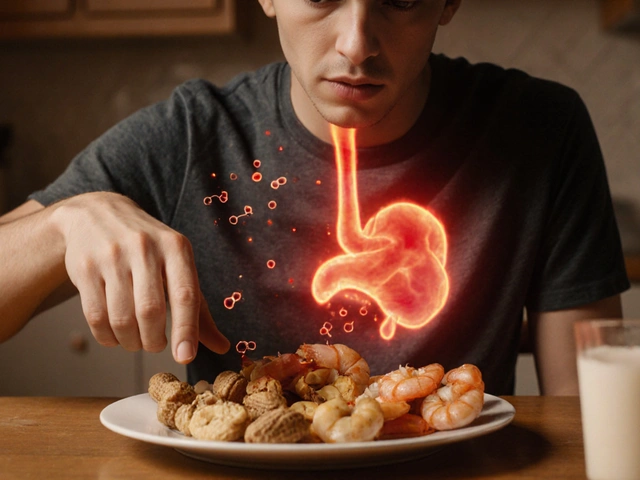
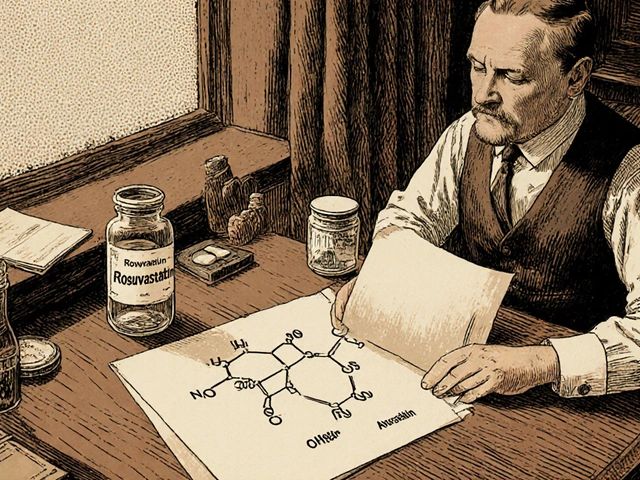



Nick Zararis
Just had to share this - I didn’t know Sudafed could do this. My dad went to the ER last winter after taking it for a cold. He thought it was just "old age." Turns out, it was the decongestant. I printed this out and taped it to his medicine cabinet. He’s now using saline rinses. Thank you for saving lives.
Sara Mörtsell
People are dying because pharmacies don’t ask questions. Why is this still legal? It’s not like pseudoephedrine is a miracle cure - it’s just a vasoconstrictor with zero medical necessity for most colds. We’re letting Big Pharma profit off men’s ignorance. Someone should sue. Someone MUST sue.
Rhonda Gentz
I’ve been thinking about this a lot - how we normalize risk when it’s invisible. We don’t think about our bladders until they scream. We don’t think about our prostates until they betray us. And then we blame aging. But it’s not aging. It’s a system that doesn’t care if you read the label. We’ve built a world where convenience overrides caution. And men pay for it in silence.
Alexa Ara
This is such an important post. Seriously. I’m a nurse, and I’ve seen this happen too many times. One guy came in crying because he couldn’t pee after taking a cold tablet. He said, "I’ve taken this for 20 years." I just hugged him. No one told him. No one warned him. Please share this with your dads, uncles, grandpas. Knowledge is the only real medicine here.
Olan Kinsella
Imagine this: You’re a man in your 60s. You’ve got a stuffy nose. You reach for Sudafed. You don’t even know what your prostate does. You just want to breathe. And then - BAM. You’re stuck. Your bladder swells like a water balloon. You scream. You cry. You’re catheterized. And the pharmacist? They didn’t even look up. They just scanned it. This isn’t medicine. This is a silent massacre. And no one’s talking about it. Not really. Not until it’s too late.
Kat Sal
Y’all need to stop acting like this is some rare edge case. This is happening to men EVERY DAY. My uncle got hospitalized after one pill. He thought he was being smart - "I only took half." NO. It doesn’t work like that. Use the saline rinse. Use Flonase. Use steam. Your body will thank you. And if you’re still skeptical? Just ask your urologist. They’ll tell you the same thing. This isn’t opinion. It’s science.
Rebecca Breslin
Wow. This is the most accurate thing I’ve read all year. I’m a pharmacist. I’ve sold this stuff for 12 years. I never asked. I didn’t think it mattered. Then I read this. I’ve changed. Now I ask every man over 50: "Any trouble peeing?" Half say yes. I don’t sell them Sudafed anymore. I hand them a NeilMed bottle. They cry. I cry. We both breathe easier.
Kierstead January
Typical liberal overreaction. Men have been taking Sudafed since the 1950s. You’re just scared of pills now. If your prostate is that sensitive, maybe you shouldn’t be drinking beer and sitting on the couch all day. This isn’t a crisis. It’s biology. Stop making men feel guilty for wanting to breathe.
Imogen Levermore
…did you know the FDA knew about this since 1998? But they didn’t act because Big Pharma donated to their campaigns? And now they put a tiny warning on the box? LOL. Also, Flonase? It’s just a gateway to steroids. They want you addicted to nasal sprays so you buy more next year. I’ve seen the documents. It’s all connected. #DeepStateMedicine 🧠💉
Chris Dockter
Just don’t take decongestants. Done. Stop overcomplicating it. Your prostate is lazy. Your body is aging. You want to feel better? Sleep more. Drink water. Don’t take pills that turn your bladder into a brick wall. Simple.
Gordon Oluoch
Men who don’t know their own anatomy shouldn’t be allowed to buy OTC meds. This isn’t a medical issue - it’s a failure of personal responsibility. You didn’t get a prostate exam? You didn’t know your IPSS score? Then you’re not a patient. You’re a liability. The system doesn’t owe you ignorance.
Tyler Wolfe
I’m 58. I’ve had BPH for 8 years. I used to take Sudafed. Then I read this. I switched to saline rinses. No more ER trips. No more panic. I just breathe. It’s not glamorous. But it works. And I’m alive. That’s enough.
Neil Mason
Just came back from Canada where they restrict pseudoephedrine behind the counter. You have to ask. You have to show ID. They ask if you’ve got prostate issues. It’s not perfect. But it’s better than here. We need that here. Simple. Human. Safe.
Andrea Gracis
Wait so if I have trouble peeing at night and I take a cold med… I could get stuck? Like… really stuck? Like… hospital stuck? I didn’t know that. My dad does that. I’m gonna tell him right now.
Matthew Wilson Thorne
Interesting. But did you cite the original 2021 JAMA Urology study? Or just a Reddit post? Credibility hinges on primary sources, not anecdotal testimonials.